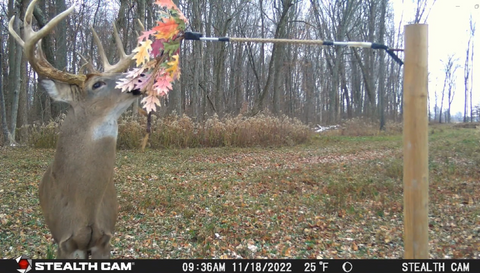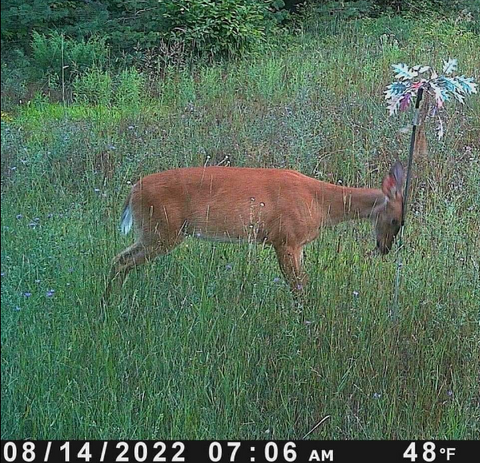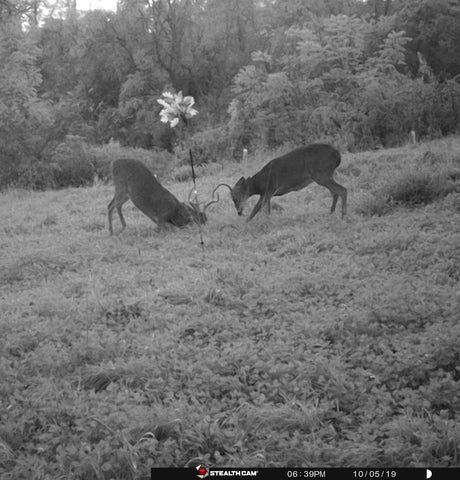Table of Contents
WHITETAIL DEER GLAND KNOWLEDGE
KNOW THE 8 GLANDS!
If you took a test right now on deer glands, how would you do? Do you know how many glands a whitetail deer has? Do you know where each gland is located? Do you know the function or purpose of each gland? If you are not sure how to answer any of these questions, you are not alone.
Over the last decade, I have been making mock scrapes and using only three glands lures. After learning more about some of the other glands, a whitetail uses to communicate with I have added more lures to my hunting arsenal. Let me help you understand the eight glands of a whitetail, their purpose and how BuckStik Products Utilizes and presents the three main communication glands creating the most powerful Communal Mock Scrape System on the Market.
GLANDS ON THE LEG
Interdigital Gland
Whitetail deer have an interdigital gland between their hooves on each foot. To see this gland, you will have to spread the deer’s hoof apart and look between them. Between the hoof, there is a small hole that allows the interdigital gland secretion to come out.
Each deer has a distinct odor. The interdigital gland allows deer to identify one another. Each time a deer takes a step, it releases a small amount of the gland secretion. Why is this so important?
The importance of the interdigital gland allows a mother to locate their fawns. Bucks can find a doe bed, check it, and follow a doe that might be in estrus. Non-receptive does will be on high alert when they smell the interdigital gland lure from a cruising buck. Deer know their home range well and like to know there are no intruders.
This is one of the three main glands BuckStik utilizes at the ground level during the season.
Metatarsal Gland
The metatarsal gland is located on the outside of a whitetail deer’s back legs. About five to six inches above the deer’s rear hooves is a white tuft of hair. Inside of the hair is an opening that is a duct for the metatarsal gland.
The metatarsal gland will give off an aggressive odor during the rut to warn other bucks in the area. Each deer will have a unique scent that it will give off. Bucks can become familiar with the individual odor of each other. The metatarsal gland seems to be larger in deer that live further north. Some biologists claim that deer are no longer using this gland. I am not sure what to think because I use the gland lure for hunting almost every year.
Tarsal Gland
A whitetail deer has two tarsal glands that are located inside the deer’s hind legs. You can find the tarsal glands where the deer’s back legs bend. The large tufted of lightly-colored hair sticks out and is strategically placed for the deer to create a unique scent specific to that deer.
Because of the unique odor hunters can sometimes smell a buck before they see him. The pungent odor is always most potent during the rut when the deer are making scrapes. When a buck is worked up, the hair on the tarsal glands can stand erect as a sign of aggression or dominance. Some deer biologists believe the tarsal gland scent can signal a doe that a buck is ready to breed.
GLANDS ON THE HEAD
Nasal Gland
The nasal glands are inside the deer’s nose. Biologists describe the glands as being shaped like almonds. The nasal glands are essential for deer. Hunters know deer rely heavily on their noses to help them detect odors in the air. But there is another vital purpose for the nasal gland.
The primary purpose of the nasal gland is to detect odors in the air to help deer survive. Deer are constantly checking the air and walking into the wind, so they know what is around them. A deer’s nose is far better than their eyes!
The second purpose of the nasal gland is two-fold. The gland lubricates the nasal passage, which allows deer to detect scents. The lubricant from the nasal gland can help deer leave their scent on licking branches.
Preorbital Gland
A deer has two preorbital glands that are just below the corner of their eyes. The preorbital gland has two different glands located in the tear duct. The sudoriferous and sebaceous glands are the glands inside of the duct. The preorbital glands are controlled by muscles and can open wider to emit an odor.
The primary purpose of the preorbital gland is a tear duct that helps lubricate the eyes. Deer will often put a licking branch in the corner of their eye. The preorbital gland will open and let the liquid from the gland cover the branch. Biologists believe this is a way that deer will self-mark areas. Older bucks often have preorbital glands that are more defined, which may be a sign of aggressive behavior towards other deer.
This is the primary gland that is used year round with the BuckStik/BuckBranch. A single spray elevated off the ground on the vine/ropes/leaves produce the greatest effect.

Forehead Gland
The forehead glands are located above the eyes and between the antlers of a buck. A doe also has forehead glands above their eyes and between their ears. The glands will start to produce an oily substance in September. As the rut moves on, the glands will secrete more oils. The secretion will cause the hair on the buck’s forehead to get darker and even reddish.
The purpose of the forehead glands on a buck is essential. As a deer marks a tree with the oily substance, it leaves some information for the other deer in the area. A deer can learn three things from a rub: First, a deer can determine the age of the deer, making the rub. Secondly, a rub can explain a deer’s social status. Finally, it can communicate to other deer its breeding status.
An older buck secretes more oils from his forehead glands. Thus, older deer will mark more trees. Some biologists believe that forehead gland secretion has a pheromone that can help a doe come into estrus.
Lastly, the Forehead gland completes the 3 gland communication system with the BuckStik. A single Spray on the forehead strip of the BuckStik will have your Bucks both young and old rubbing all day long.

Salivary Gland
The salivary gland is inside the mouth of the deer. The glands are on the roof of the deer’s mouth, in their cheeks, and gums. Deer use their salivary glands for more than just digesting food.
The primary purpose of these salivary glands is to produce saliva. The saliva will help a deer digest food it eats and is also vital for marking. Deer will deposit saliva on branches, vegetation, and trees to let other deer know they are in the area. When a deer takes the licking branch in its mouth, it will bite down with their teeth. Biting the branch allows the deer to deposit their scent to the licking branch.
NEWEST GLAND
Preputial Gland
This gland is located in the penal sheath of the buck. It has two primary purposes: lubrication for breeding, and it contains sperm for reproduction. The preputial gland is the newest gland that has been found and studied. Deer biologists believe it to be used for communication during breeding, but there is no hunting use at this time.
In Summary,
These eight glands are used daily in the whitetail world. Some are used more than others, and some are only used during certain times of the year. Deer use non-verbal communication to interact all of the time.
The BuckStik is a true pheromone communication system that ideally presents the Three Main Communication Glands at the ideal height for interaction. By presenting the Preorbital gland elevated in the vine/ropes, the forehead gland in the rubbing strip, and the interdigital gland a ground level it creates the ultimate communal mock scrape system.
Gland Presentation combined the the BuckStik’s ability to capture and hold deer DNA (Gland Secretions, hair) better than anything natural create an amazing communication hub that will last for years. Never again will you have to start over from scratch with a natural branch as the BuckStik lasts multiple seasons.
In the next post, I will give you some strategies on how to use each of the gland lures while hunting.
By Brian Kightlinger












































